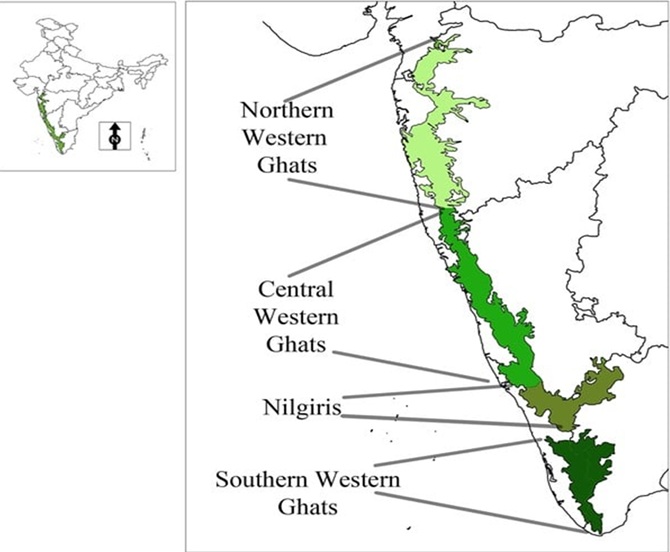| (GS III- Environment and Ecology) |
Recently, the Karnataka government rejected the Kasturirangan Committee’s report for the environmental conservation of the Western Ghats. The state government argued that the report exaggerated the extent of the Ecologically Sensitive Area (ESA), which could hinder developmental projects. This decision has once again revived the debate between development and environmental conservation.

Kasturirangan Committee: Key Recommendations
|
Point
|
Details
|
|
Formation
|
Formed in 2012 by the central government following objections from states to the Gadgil Committee report.
|
|
Chairperson
|
Dr. K. Kasturirangan
|
|
Objective
|
To study the environmental status of the Western Ghats and provide policy recommendations for its conservation.
|
|
Key Recommendations
|
- Declare about 37% of the Western Ghats (≈60,000 sq km) as ESA.
- Ban mining, thermal power plants, large construction projects, and red-category industries.
- Promote sustainable development with the participation of local communities.
|
Geographical and Ecological Significance of the Western Ghats
- The Western Ghats span six Indian states — Gujarat, Maharashtra, Goa, Karnataka, Kerala, and Tamil Nadu.
- Its total length is approximately 1,600 km, running parallel to India’s western coast.
- It serves as a major watershed region of India.
Ecological and Biodiversity Importance
- Biodiversity Hotspot: The Western Ghats are considered one of the eight “hottest hotspots of biodiversity” in the world.
- UNESCO World Heritage: In 2012, 39 sites in the Western Ghats were recognized as UNESCO World Heritage Sites.
- Endemic Species:
- 50% of India’s amphibian species and 67% of its freshwater fish species are endemic to this region.
- Examples: Nilgiri tahr, Malabar civet, Lion-tailed macaque.
- Water Resources Contribution:
- The rivers originating from the Western Ghats meet the water needs of around 245 million people.
- Major rivers like Godavari, Krishna, Kaveri, and Periyar originate here.
- Forest Wealth:
- 63% of India’s evergreen tree species are found here.
- It is a major center for medicinal plants.
Major Threats to the Western Ghats
|
Threat
|
Details
|
|
Human Activities
|
Rapid urbanization, unregulated tourism, expansion of agricultural land, and mining have damaged the ecology.
|
|
Mining & Industry
|
Extraction of iron ore, bauxite, manganese, etc., has led to soil erosion and water pollution.
|
|
Climate Change
|
Changes in rainfall patterns, droughts, and increased landslides.
|
|
Deforestation
|
Illegal logging is causing fragmentation of wildlife corridors.
|
|
Policy Disagreements
|
Opposition from affected states—especially Karnataka, Maharashtra, and Goa—has delayed ESA notification.
|
Development vs. Conservation Controversy
- State governments argue that expanding ESA limits would affect mining, dams, roads, and infrastructure projects.
- Environmentalists argue that long-term economic prosperity is only possible if ecological stability is maintained.
Way Forward
- Institutional Reforms:
- Establish the Western Ghats Ecology Authority.
- It should handle monitoring, policy implementation, and coordination.
- Financial Incentives:
- Create the Western Ghats Sustainable Development Fund to financially support green development projects.
- Public Participation:
- Involve local communities and village councils in conservation decisions.
- Promote eco-tourism to generate environmentally-friendly employment.
- Policy Coordination:
- Ensure balanced policy-making between the central and state governments.
- Strictly implement Environmental Impact Assessments (EIA).
Conclusion
- The Western Ghats are not only a treasure of India’s biodiversity but also the “lifeline of India’s water resources.”
- Its ecosystem is extremely fragile, with numerous wildlife corridors.
- Active participation of local communities, environmental education, and a sustainable development approach are essential for its conservation.
“Development is meaningful only when it is balanced with the environment.”



